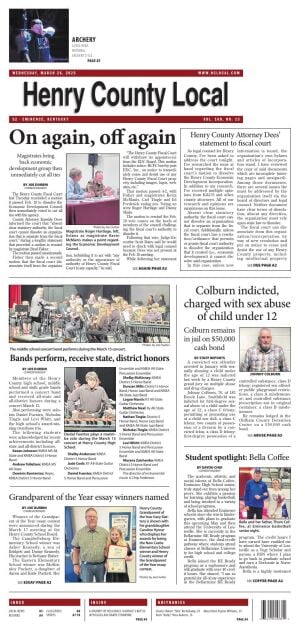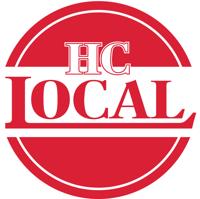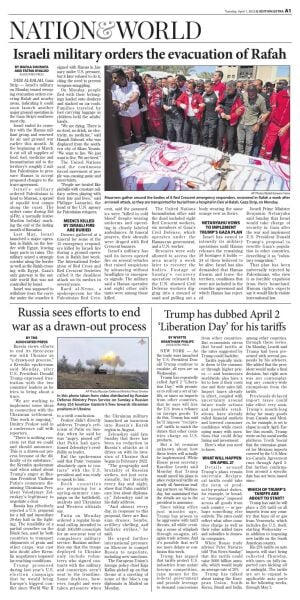This is part four of a six-part series being produced by the Henry County Local to help the Henry County Extension Office celebrate its 100th anniversary, which will culminate with an April 17 event at its office.
This segment is from 1955 through 1975 and includes the personal writings of former Extension agents.
The first segment was written in April 1985 by Steve Moore, County Extension Agent for Agriculture.
“From 1939 to 1956, the Agriculture and Home Economics agents worked their programs and shared 4-H responsibilities. The first Assistant County Agent began in 1956, with primary emphasis on 4-H youth work. The position was known as assistant county agent until the late 60’s when it became County Extension Agent for 4-H, with full time duties in youth development.
“The longest time worked was Mr. O. D. Perkinson, who served as County Agent for Ag from 1948 to 1966, over 18 years.”
In an undated 1985 writing by Steve Moore titled “EXTENSION BEGAN IN HENRY COUNTY 60 YEARS AGO:
“The post war years found Extension dealing with a changing agricultural community. Tobacco, as always, was the primary cash crop in Henry County, but dairying was making a rapid run as an important farming enterprise. New machines to plant, till, and harvest crops were being introduced every year, and more extensive use of electricity was allowing more refrigeration of farm commodities, such as milk, and were allowing farmers to milk more cows. A county-wide Extension Advisory Committee was meeting regularly to ensure that Extension work continued to be sensitive to the needs of the county.
“The 1956 Extension Advisory Committee Chairman was John Barnett Crabb and the Secretary was J.G. Hieatt. A fairly lengthy list contains names of many farmers who served in advisory capacities to the County Agent for tobacco, agronomy other than tobacco, poultry, dairy, sheep, and beef cattle.
“The 1956 Tobacco Program began with a county-wide tobacco leaders meeting where they planned for the 11th Annual County-Wide Tobacco Meeting at the Eminence Theater. Just as though the preceding decade, Mr. Russell Hunt of the University of Kentucky and Mr. John M. Berry were the principal speakers, and the attendance was over 200. The championship cup for the 4-H Tobacco Project went to Eddie Foree of Sulphur. The County-Wide Tobacco Field Day was held at the James Singleton farm near New Castle. Variety demonstrations were very closely inspected. The tobacco crop averaged 1615 lbs. per acre for a total of nearly 7 million pounds. The price of $64.22 per hundred lbs. yielded a gross of $4.4 million.
“Pasture variety tests in 1956 pointed to the conclusion that orchard grass, red clover, and alfalfa were the plants best suited to Henry County pastures. A rainy spell caused as much as 50% of the first cutting of alfalfa to be lost or damaged, and County Agent, O.D. Perkinson had a good opportunity to sell the idea of putting first cutting alfalfa into the silo.
“In dairy work, 10 grade C shippers graded up to grade B. A favorable milk price and 2 years of good hay and pasture weather made the dairy picture pretty bright by 1957. Two dairy shows were organized, 7 herds were on DHIA testing and several others were on a program known as weigh-a-day-a-month. The Artificial Breeders Association was doing well, with 1,600 cows in the program, 1 full-time and 1 part-time technician.
“The Kentucky Cow and Calf plan paid off in a good way in 1956, as the abundance of grass helped produce top quality feeder calves...
“1956 also brought to Henry County the first Assistant County Agent Wayne Sininger, who joined O.D. Perkinson and Ruth Marcum.
“1957 brought a small decrease in yield and price for the tobacco crop, and as a result, the crop grossed $4 million. The Extension Program for tobacco was much the same as in the preceding years, with an excellent beginning with the winter meeting.
“Soil testing was beginning to become very popular, with a laboratory operated in the county. Many farmers brought samples in to find how best to manage their soils for crop production.
“Dairy work included DHIA and WADAM, which enrolled 23 herds and 360 cows.
“Forage work was enhanced once again by weather. One of the best hay years on record helped several farmers achieve 4 and 5 ton yields in alfalfa. Forage plots on pasture fertilization were shown at a Farm, Home, and Bankers Field Day at the Buskirk farm in the Orville Community.
“The 1958 Extension Report for Agriculture lists Brucellosis Testing in Dairy Cows as a primary program. Leaders meetings were held, with leaders taking certain roads in the county to sign up the dairy farmers. With the necessary signers, the program was begun under the direction of the State Veterinarian’s Office. Milk production was listed at 4000lbs. of milk per cow as an average, with 185 lbs. of butterfat. A goal was set to raise milk production to 7000lbs. through more use of artificial breeding and improved forage programs...
“A large section of Henry County was without phone service in 1958. The County Agent and leaders visited door to door in the Orville and Gestville communities and found 80 families ready to go on the line on 12 miles of road. Even though the phone company questioned the survey, by the end of the year, the poles were up, and wire was being strung.
“Other agricultural work in 1958 included a Field Day at the Eden Shale Farm near Owenton, a Winter Tobacco Meeting, a County-Wide Tobacco Tour in the Sulphur Community, and a County-Wide Sheep Meeting.
“The 1959 Henry County Extension Staff included O.D. Perkinson, Agricultural Extension Agent; Wayne J. Sininger, Assistant Agricultural Agent; and Geraldine Bentley, Home Demonstration Agent.
“General farm income faltered during 1959, which caused many Henry Countians to seek employment in Louisville. As most who traveled to Louisville were men, this left several farms to be tended by the wives. The standard of living was thought to be fairly high, with most people able to add electrical appliances and own a car. To keep the standard of living high, the off-farm jobs taken were to change the agriculture extension program, particularly the attendance of educational meetings...
“In dairy work, a few herds were found to have brucellosis, and average production was felt to be much too low, below the USA average. Two Dairy Specialists and Mr. Marshall Carpenter of KABA were speakers on a program which encouraged better record keeping. About five dairymen built silos during the year, and culling stepped-up noticeably. Alfalfa production was increased.
“Even though good rams were available locally in 1959, lamb prices were so low that farmers just weren’t going to buy good rams at an increased price. Several farms were selling their flocks with some farmers giving as their reason for quitting that profit did not justify the time and trouble required to control parasites and foot rot.
“Increasing income from swine, during a down year in agriculture, was a bold venture. Twenty-six farmers formed a feeder pig association, agreeing to sell their pigs as a group. Dr. Charles Barnhart was the speaker at the Farm, Home, And Bankers Field Day, and he led a very informative discussion of swine production. The Feeder Pig Association had mixed results because in May, prices fell drastically and several of the group fed the pigs out.
“When the 1960 Extension report was written, Mr. Perkinson lists two consecutive years of drought. While this was not thought to have decreased farm income greatly, the urge for more income was causing more people to seek part- or full-time employment in Louisville. The overall situation for Extension was healthy, which lots of cooperation of a good Extension Advisory Committee and other organizations and agencies...
“The committee for eradicating Brucellosis was well organized at the start of the year, and this was a major Extension work program through the year. The testing was completed, the infection rate was low enough that Henry County could be declared modified accredited.
“Tobacco remained the main commodity interest. The meetings and the field day were well attended, with the big question again being “pounds or quality?”. Neither was evident as the drought allowed a yield of only 1600 lbs. per acre which averaged $66.15 per hundred lbs. About 60% of the farmers used MH_30, and probably 90% of the tobacco was stripped in 3 grades. The county 4-H Tobacco Project Champion was Dewey Lee Purvis.
“The County Extension Staff changed somewhat in 1961, with Howard Baker replacing Wayne Sininger as Assistant County Agent. (both are presently County Agents for Agriculture in Bracken and Grant Counties, respectively.)
“Another change occurred affecting Extension program in that the Eminence Fairgrounds was sold. After two years of depressed farm income, money was tight for many Extension programs, especially 4-H.
“Tobacco made a considerable comeback to the county economy, as the yield jumped to over 2,000 lbs. per acre and brought $66.66 per hundred lbs. Almost $5.8 million was brought into the farm economy with this big crop, an increase of over $1.4 million over 1960. The price — quantity — quality question was still the big concern, being discussed at all tobacco meetings. Alvin Tingle was the county 4-H Tobacco Project Champion, announced at the Winter Tobacco Meeting.
“A lot of alfalfa was sown in the spring of 1961, and the good rains made one of the best hay years ever. Most of the alfalfa hay was fed to dairy cows. Dairy work included work with artificial breeding, DHIA< WADAM, and 4-H youth work. The artificial breeding program was doing well, and several herds were on record keeping programs. The WADAM program was in jeopardy because the computer had broken down.
“The feeder pig sale organization handled nearly 2,000 pigs, but low prices were blamed for slow growth of this enterprise. The emphasis was on meat type hogs, and a Rotary Club and 4-H club Pig Chain were helping show what a meat type log was like.
“During the 1962 Extension year, another change took place in the staff. Miss Jennie Arvin was appointed Home Demonstration Agent in September.
“There were some 8,000 cows being milked in 1962, with annual production of 7,000 lbs. per cow and 2,600 cows bred artificially. The agent worked closely with the Artificial Breeders Association, the DHIA< and the June Dairy Month Committee.
“The feeder pig sales organization members and the agent visited Fuller Farms of Indiana. There they looked at the finishing operation and signed contracts to supply 4,500 pigs during 1963...
“While the weather cooperated with the farmers in preceeding years, a late summer drought in 1964 hurt both crops and livestock. With excellent forage years came more livestock, so Henry County was overstocked, and several animals were sold because there was not sufficient hay to carry them through the winter...
“The years 1963 and 1964 saw changes in the overall Extension Service in Henry County. In 1963, the Extension Board was created as a taxing district to fund the Extension program. Before that time, the fiscal court had budgeted the funds to operate the Extension Office and fund part of the salary of the Assistant County Agent. It might be noted that the Extension Offices (Agriculture, Home Economics, 4-H, and the Secretary) were located in the 2nd floor of the north wing of the Courthouse. In 1964, Katie Sue Brumagen was hired as Home Demonstration Agent.
“The fourth decade of Extension work in Henry County ended in 1965, with still another change taking place. Roger Leggett became the Assistant Agricultural Agent, joining Katie Sue Brumagen and O. D. Perkinson...
“An area farm analysis group was begun with fifteen farmers from Henry County. A farm and home development group, which had been in operation for several years, heard Stephen Q. Allen, a UK Economist, speak about record keeping and income tax preparation.
“Extension work in Henry County at the end of its fourth decade of existence (1956-1965) was well planned by local leaders groups...A major thrust was the development of a properly set-up water district hopeful to get running water to 2/3 of the county.”
Jerri Cockrel, County Extension Agent for Home Economics wrote in April 1985, “Commodity foods demonstrations were held to teach the use of dried milk, rice, cornmeal, etc. In 1966 the Head Start program in Henry County was going on, so Ms. Brumagen worked out the parent education aspect of that program.
“Ms. Brumagen transferred to the 4-H Agent position Dec. 31, 1970. She married Robert L. Yount and is living near Bethlehem.
“Home Economics 1970-1985 — Eloise J. McKitrick was the first black Home Economics Agent in Henry County. She served as agent from January 1971 to August 1973 and was well liked by everyone. In addition to working with 13 clubs in the Homemaker program, in 1971 the Expanded Food and Nutrition program was started. In this program part time paraprofessionals were hired to visit in the home of low income families and teach food purchasing, preparation, nutrition and meal planning.
“Lucille Durham from Campbellsburg and Peggy Billings from Point Pleasant were hired. Mrs. Billings resigned in 1973 and Mrs. Durham is still working. The Home Economics Agent supervises the EFNEP program and paraprofessionals.
“Ms. McKitrick returned to college working on advance degrees and the last report was that she is teaching at a college in Ohio.
“Velva Jerdene Cockrel (Jerri) started work in Henry County September 1, 1973. Juanita Mahoney replaced the position Peggy Billings vacated with EFNEP and worked until she retired in March 1982.”
In a Henry County Local article dated December 24, 2014, titled History of Henry County Extension — the Secretaries, Steve Moore wrote, “We have a big gap in knowledge of years of service 1959 to 1973, but we know that Grace Powell, Joyce Spear, Valerie Shuck Moffett and Ruthie Tingle Smith served as Extension Secretaries during this time. Valerie Shuck Moffett left the Extension Service and became secretary to Henry County Judge Pid Smith and later served as Deputy County Judge Executive. Ruthie Tingle Smith later served in the Henry County Court Clerk’s Office with Clyde Ellis and retired as a teacher in Henry County Public Schools.
“When I hired on as Henry County Extension Agent for 4-H in 1974, I was lucky that Sheila Marie Davis Atchison had become the Extension Secretary in 1973. Sheila seemed to already know everybody, and knew who they were kin to, a handy bit of knowledge for any young 4-H Agent to have as he went about recruiting 4-H leaders and program sponsors. I learned a lot about the county through many pleasant conversations with Sheila as I sat near her desk. Sheila was extremely pleasant and helpful to many clients of the Extension Service until 1978, when she hired into the ASCS (now FSA) office.”
In next week’s edition of the Local we will focus on 1975 to 2000 using past Local articles and personal writings of past or current Extension employees.












